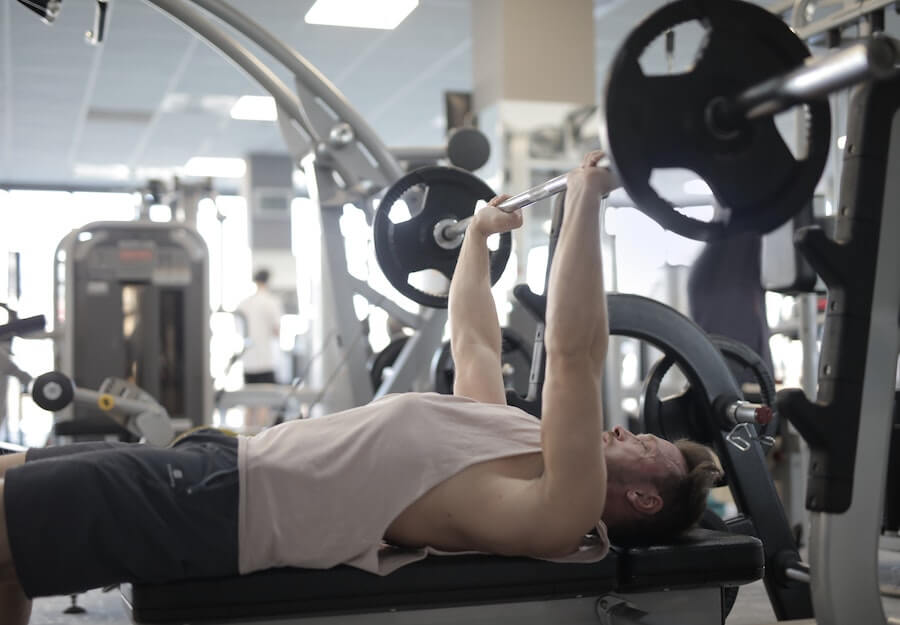Bench press and chest press are two upper body exercises that target the chest, shoulders, and arms. If you are looking to transition from chest presses to bench presses, you’re in the right place.

Here’s a guide to help you safely and effectively make the conversion.
The Chest Press vs. the bench press
The chest press is a popular exercise for strength training and bodybuilding. It primarily targets the chest muscles, specifically the pectoralis major and minor muscles.
It is often done using various equipment, such as barbells, dumbbells, or weight machines. The basic chest press exercise involves lying on a flat bench with your feet firmly planted on the floor.
You hold a barbell, dumbbell, or grip handles of a weight machine with your hands, positioning them slightly wider than shoulder-width apart. The starting position is with your arms extended and the weight held directly above your chest.
The bench press is also a strength training exercise primarily targeting the chest, shoulders, and triceps muscles. It is typically performed lying on a weight bench with a barbell or dumbbell.
To convert from a chest press to a bench press, you would typically transition from using a machine to performing the exercise with free weights on a weightlifting bench. This change allows for a greater range of motion.
It also allows for increased muscle activation due to the involvement of stabilizer muscles and improved functional strength. Which one is harder?
A major difference between a bench press and a chest press is the equipment used. The bench press is a free-weight exercise.
On the other hand, the chest press is a machine exercise. The bench press is relatively more difficult than the chest press.
With the chest press, you can raise more weight. It is also the preferable one out of the two for newbies or those recovering from injury.

It is advisable to perform the bench press with a spotter who would ensure a flawless technique. This is because the bench press is more prone to cause injury than the chest press.
Can you convert from chest press to bench press? It can be difficult to convert from chest press to bench press. However, it is not impossible.
You must adjust your weight proportionately from chest to bench press. You’ll need to start lighter than you can imagine.
A general practice is to start at around 50% of your maximum chest press weight. You can work your way up from there.
The typical conversion between the 1RM (max) bench press on a machine versus free weights varies. This would depend on the individual and the specific machine or weights used.
However, as a general rule, it is often said that a 1RM on a machine will be lower than a 1RM on free weight. This is due to the lack of stabilizer muscles.
Some people may find it easier to perform a 1RM on a machine due to the guided movement and support provided by the machine.
Otherwise, some may find performing a 1RM on free weights easier due to the greater range of motion and muscle activation required.
NOTE
These are just generalizations. Individual variations, technique, and muscle activation affect the conversion. It’s also important to consult a professional and do proper form checks before attempting a 1RM.
How soon can you transition from Chest press to bench press?
Consider transitioning from chest to bench press if you feel confident in your technique. Also, you can do this if you have developed adequate strength and stability and are comfortable with free weights.
However, consulting a fitness professional or trainer is always a good idea. They can assess your readiness and provide personalized guidance based on your circumstances.
Understand the Difference
First off, understand the difference. As previously mentioned, the chest and bench press are similar exercises but with a few key differences.
The chest press is typically performed on a machine or with dumbbells. The machine version usually involves sitting or lying down and pushing handles or levers away from the body.
You lie on a flat bench with dumbbells and press the weights while holding them in each hand. The bench press, on the other hand, is performed on a weightlifting bench using a barbell.
The barbell is held with both hands, and you lower it to your chest and push it.
Master Proper Form
Before progressing to bench presses, ensure you have mastered the proper form for chest presses. This includes maintaining a stable back position.
Keep your core engaged, and use controlled movements throughout the exercise. A solid foundation in chest presses is important before moving on to bench presses.
Start with an empty Barbell
When transitioning to bench presses, starting with an empty barbell is advisable. This is until you are accustomed to the movement and build confidence.
The standard barbell in bench presses weighs 45 pounds (20 kg). If this is too heavy for you initially, you can use lighter barbells or training bars that weigh less.
Adjust Your Grip
Your hands are typically positioned on the handles or dumbbells for the chest press. In the bench press, you’ll grip the barbell.
Place your hands slightly wider than shoulder-width apart on the bar, with your palms facing forward. Experiment with different grip widths to find what feels most comfortable for you.

Engage Your Stabilizer Muscles
Unlike the chest press machine, the bench press requires you to stabilize the weight throughout the movement. This engages muscles like your shoulders, triceps, and core.
Make sure to squeeze your shoulder blades together. Also, keep your feet planted firmly on the ground, and engage your core to maintain stability during the bench press.
Start with Light Weights
Assessing how much weight you should be bench pressing is a good idea. This would reduce the chance of injury while increasing the effectiveness of your training.
When starting with the bench press, begin with lighter weights than you used for chest presses. This will allow you to focus on proper form and gradually build strength.
As you become more comfortable and confident, gradually increase the weight you lift. To make it easier, estimate how much weight you should be bench pressing.
Increase Weight and Progress
As you progress, aim to increase the weight you lift while maintaining good form gradually. Add weight incrementally, ensuring you can complete the desired repetitions with the proper technique before progressing.
Focus on progressively improving your strength and challenging yourself.
Seek Guidance if Needed
If you need help with proper form or technique, consider working with a qualified personal trainer or strength coach. They can provide guidance and help you refine your technique.
Moreover, they can ensure that you progress safely and effectively. Having a spotter or using safety bars or a power rack is always a good idea. You can prevent accidents or injuries.
Remember,
It is essential to listen to your body. Start with appropriate weights, and progress gradually to avoid injuries.
Remember to warm up adequately before exercising, including the bench press—progress at a comfortable pace. Good luck with your transition from chest presses to bench presses!

Some people collect expensive old cars, and I’m into collecting bikes. I have 15 different bikes: special mountain bikes, sportbikes, professional, amateur, and city bikes. My friends and colleagues call me a ‘bike expert’ because I give advice on how to choose the right bike.
I’m also a massive fan of gym culture and heavyweight workouts. I met Alan at my local gym, and we’ve become friends quite soon. His idea of starting a sports blog seemed interesting to me, so I agreed to help.





